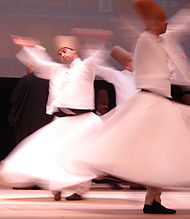- Gurdjieff movements
-
The Gurdjieff movements are the name given to the collective body of sacred dances that were collected or authored by G. I. Gurdjieff and taught to his students as part of the work of self observation and self study.
Gurdjieff taught that the movements were not merely calisthenics, exercises in concentration, and displays of bodily coordination and aesthetic sensibility: on the contrary, in the movements was embedded real, concrete knowledge, passed from generation to generation of initiates - each posture and gesture representing some cosmic truth that the informed observer could read like a book. Certain of Gurdjieff's followers claim that the Gurdjieff Movements can only be properly transmitted by those who themselves have been initiated in the direct line of Gurdjieff; otherwise, they say, it leads nowhere.
The movements are purportedly based upon traditional dances that Gurdjieff studied as he traveled throughout central Asia, India, Tibet, the Orient and Africa where he encountered various Indo-European and Sufi orders, Buddhist centers and other sources of traditional culture and learning.[1] However, Gurdjieff insists that the main source as well as the unique symbol of the Enneagram was transmitted to him as an initiate in the Sarmoung Monastery. There were literally thousands of movements collected and taught by Gurdjieff throughout his teaching career. The music for the movements was written by Gurdjieff and Thomas de Hartmann, as well as British composer Edouard Michael.
A brief glimpse of the dances appears at the very end of the motion picture about Gurdjieff, Meetings with Remarkable Men, produced and directed in 1978 by Peter Brook.[2]
An example of Gurdjieff's later series of movements (The 39 series) are:
- 1. The Automat.
- 2. Prayer in Three Parts.
- 3. Four Tableaux.
- 4. Prayer for Instruction.
- 5. Pointing Dervish.
- 6. Movement in canon
- 7. Esoteric
- 8. Triads in Pairs. Complexity in Simplicity.
- 9. 'Olbogmek'. Double Multiplication
- 10. (A light dance with counting in canon)
- 11. Lord Have Mercy.
- 12. Halleluia
- 13. (A prayer movement)
- 14. Reading from a Sacred Book
- 15. (Tibetan) Days of the Week.
- 16. -- 17. Multiplication of Enneagram
- 18. -- 19. Stop Exercise. 'Frightened'
- 20. Six Displacements. Dervish exercise.
- 21. Remorse of Conscience
- 22. of Mesoteric series
- 23. -- 24. Chadze Vadze (Lord, Mercy!)
- 25. Black and White Magic.
- 26. (A multiplication)
- 27. (A canon)
- 28. -- 29. -- 30. Canon of Six Measures. A 'cosmic' dance.
- 31. Fifteen Rythmns. Getting up and Down
- 32. Automaton.
- 33. Premier exercise apri le retour d'Amerique
- 34. (A continuous multiplication)
- 35. -- 36. Dervish Movement. People scattered about
- 37. -- 38. (A canon)
- 39. (Thinking, Feeling, Sensing)
References
- ^ Toussulis, Yannis; Darr, Robert Abdul Hayy (1 April 2011). Sufism and the Way of Blame: Hidden Sources of a Sacred Psychology. Quest Books. pp. 222–. ISBN 9780835608640. http://books.google.com/books?id=C7I4RqeSpV4C&pg=PA222. Retrieved 14 April 2011. "Moore also re- ports that an extensive study of Mevlevi (Sufi) music and movements was conducted by Gurdjieff"
- ^ Panafieu, Bruno De; Needleman, Jacob; Baker, George (September 1997). Gurdjieff. Continuum International Publishing Group. pp. 28–. ISBN 9780826410498. http://books.google.com/books?id=GV0dhZxB91EC&pg=PA28. Retrieved 14 April 2011.
External links
[http://www.4thway.eu authentic GGURDJIEFF' teaching
- Gurdjieff Heritage Society resource regarding Gurdjieff Movements and music
- Gurdjieff Movements
- The Fourth Way Archive
- A Demonstration of Gurdjieff Sacred Dances
- GurdjieffArabic.Org نشرة عربية عن تعاليم جورج إ. غوردجييف
Categories:- Fourth Way
- Ritual dances
- Sacred dance
- Dance stubs
Wikimedia Foundation. 2010.

